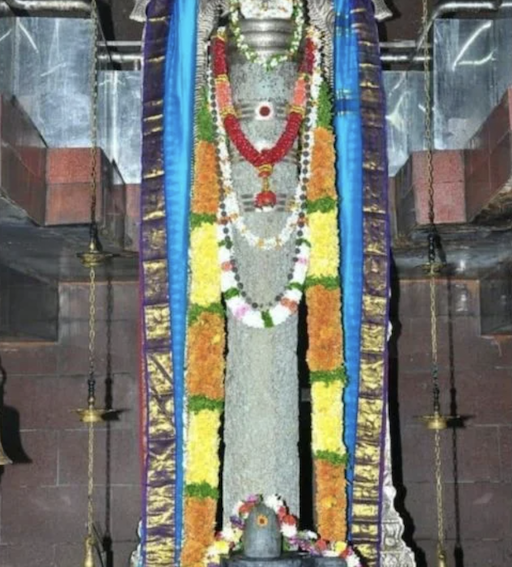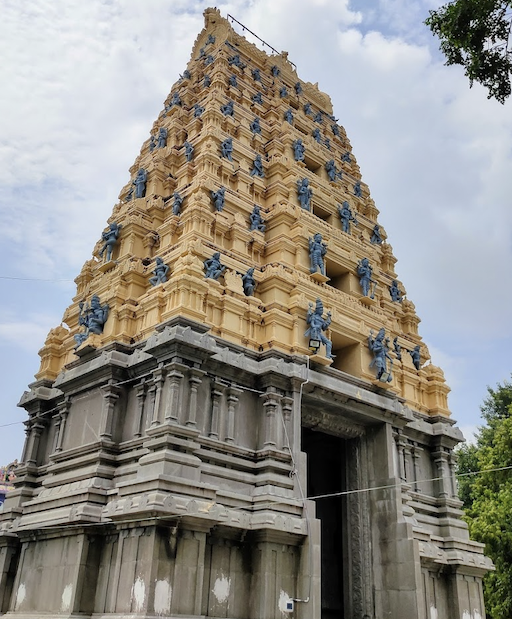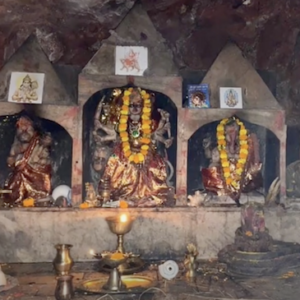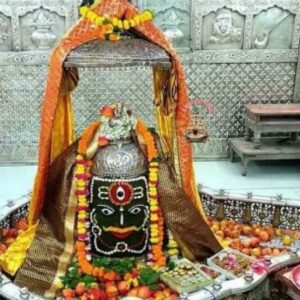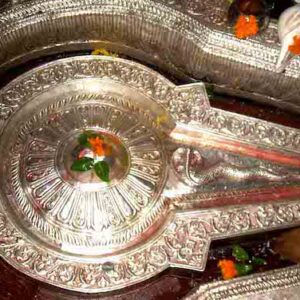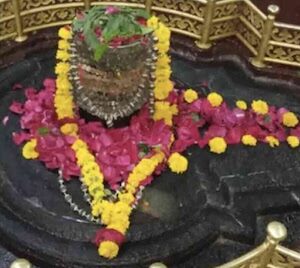This is a consecrated linga of Shri Amararama installed by Indra Deva, one of the part of Tarkasura’s Shiva Linga broken by Lord Karthikeya.
There is a place to sit and meditate. You can go into meditative states here effortlessly.
How to get there:
The temple is located 32.9 kms North of Guntur.
Map: https://maps.app.goo.gl/fEnFNfvKQgSC5rnj6
About Sri Amrarama Linga
The most popular historical mythology surrounding the Amravati temple is that a 15-foot Shiva Lingam was affixed to the ground to prevent its expansion. Blood seeped out when the nail was driven into the Lingam, leaving a scarlet mark at the top.
The Skanda Purana describes the Amaravati Temple’s unique history. According to the Purana, near the conclusion of Dwaparayuga, around 5053 years ago, the Sounakadi saints inquired Maharishi Narada about the path to nirvana. Lord Krishna, according to Maharishi, created the River Krishna so that saints could gain salvation by bathing in its waters. Any devotee who remains here for three days, bathes in the river’s holy waters and worships Lord Amareswara will achieve liberation. Therefore, the importance of the location necessitated the construction of the temple, as anyone who dies here will be absorbed by Lord Shiva.
According to another version, when the demons destroyed the gods at Varanasi, Lord Shiva arrived to defeat their demons. In addition, devotees believe that the god Indra installed the Shiva Lingam in this temple.
According to some, the temple was originally a Buddhist stupa; hence, the base of the Amaravati Temple retains Buddhist architectural characteristics. The Mula Virat within the sanctum is a lotus medallion made of white marble, a characteristic of Buddhist architecture.
The Amaravati Temple is constructed in the Dravidian style on a tiny island called Krouncha Shaila. The shrine is surrounded by four gopurams and a Vimana, all constructed in the Dravidian style. The wife of Proli Nayudu, the then-minister to the Kota monarch, Ketaraja, engraved the inscription on the Mukhamantapa pillar. Similar inscriptions appear on the temple walls as those of the Kota chiefs of Amaravathi and Sri Krishnadevraya, king of the Vijayanagara Empire.
There are three concentric circles within the temple. While the first circle contains the temples of Mahishasura Mardini, Veerabhadraswamy, Omkareswara Swamy, Guru Dattatreya, and Agasteswara Swamy, the second circle contains the temples of Vinayaka, Kalabhairava, Anjaneya, Nagendraswamy, and Kumaraswamy, as well as a statue of Lord Krishna beneath a tree. The temples of Kasi Viswanatha, Mallikarjuna, Pushpadanteswara Swamy, and Kalahasthiswara are found in the third circle, which is a little above the second. At the center of these three circles lies Amaralingeswara Swamy, a Hindu deity. Kalahasti temple has the solution for Rahu Ketu Puja.
In addition to its participation in the daily worship of the Lord, the temple trust of Amaravati Temple also engages in various charitable activities for the overall advancement of society.
Temple Architecture
The principal deity takes the form of a 15-foot-tall Shiva Lingam. The temple consists of three stories with four pillars facing each of the four cardinal directions. On each temple’s four corners are towers constructed in the Dravidian architectural style.
Kaala Bhairava appears on the second level as Kshetra Palaka. Srisaila Mallikarjuna is located in the south-west of the third level, Kashi Vishweswarar in the north-west, Chandiswara in the north-east, and Srikalahasteswara in the south-east.
The Kota chiefs of Amaravati wrote several inscriptions on the walls of the Amaralingeswara temple. Legendary Vijayanagara Emperor Sri Krishnadevaraya left inscriptions on the temple walls. Ketaraja’s wife, who was the minister to the Kota king, also left an inscription. King Vasireddy Venkatadri Naidu rebuilt the Gopuram of the temple because it had developed cracks. During this refurbishment, they discovered 1800-year-old relics in the foundation pits.
The Shiva Lingam is the primary deity. People revere Shiva as Amareswara, and Bala Chamundika is his consort. To visit the god and perform daily rituals, Archakas must ascend a pedestal platform to reach the Shiva Lingam. The top of the Lingam is stained red. A nail prevented the Linga from growing any farther. Blood began to flow when the nail pierced the Lingam, and devotees continue to observe the stain to this day.
Significance of Amaravathi Amara Lingeswara Temple
According to the Skanda Purana, at the end of the Dwapara Yuga and the beginning of the Kaliyuga, Sage Sounakadi questioned Sage Narada about the most effective means of attaining salvation. The latter recommended that Sage Sounakadi take a daily bath in the Krishna River and reside on its banks, which Krishna had created.
Sage Narada taught Sage Sounakadi the story of the Amareswara temple, explaining that Shiva materialized as a Lingam to grant the wishes of his devotees. He added that a person who washed in the Krishna River and worshipped Amareswara in this temple would be sinless. The devotees who remained at the location for three days and worshipped Shiva with devotion would reach Shiva Loka. Here, Shiva would absorb any devotee who died.
About Pancharama Kshetras
The Pancharama Kshetras (Sanskrit: पञ्चआरामक्षेत्र, romanized: Pañcārāmakṣetra) or the Pancharamas are five ancient Hindu temples dedicated to the deity Shiva in Andhra Pradesh. According to regional legend, the lingams at these temples (called aramas) are made from a single lingam.[1]
Legend
As per regional tradition, a lingam was owned by the asura king Tarakasura. Due to his possession of the lingam, he was invincible in battle. In the war between the devas and the asuras under Tarakasura, Kartikeya and Tarakasura met in combat. Kartikeya used his weapon of shakti to kíll Tarakasura. By the power of this weapon, the body of Tarakasura was torn to pieces. But to the astonishment of Kartikeya, all the pieces reunited to give rise to a revived Tarakasura. He repeatedly broke the asura’s body into pieces, and yet the pieces re-unified repeatedly.[2]
Even as Kartikeya grew baffled, Vishnu appeared before him and informed him that Tarakasura would be resurrected as long as the lingam he wore on his form was intact, and hence the lingam would have to be shattered for his victory. The deity also stated that after breaking, the pieces of the lingam would try to reunite. To prevent the lingam from reuniting, all the pieces would have to be established in the places where they would fall, by way of worshipping them and building temples over them.[3]
Heeding the words of Vishnu, Kartikeya used his agneyastra (a celestial weapon of fire) to break the lingam that was worn by Tarakasura. The lingam broke into five pieces, and started to reintegrate to the chant of the sacred syllable Om. Surya, by the order of Vishnu, established the pieces where they fell and worshipped them by building temples over them. After the consecration of the temples, the pieces stopped their attempts to reunite and became famous as the Pancharama Kshetras.[4] All the five lingams in these five places have scale-like marks on them, which are believed to have formed by the power of the agneyastra used by Kartikeya.
Temples
These places (or Aramas) are as follows:[5]
- Amararama (in Amaravathi): Amaravathi is in the Palnadu district, on the banks of the Krishna river. The deity Amara Lingeswara is believed to have been worshipped by Indra here. The temple is old and in three circles with many temples within the compound. Bala Chamundeswari is the goddess venerated here. The Venu Gopala Swami temple is also located in the campus of the main temple.
- Draksharama (in Draksharamam): This is near Ramachandrapuram. The temple is very big and has three circles as compounds. It is under the control of the Archeological department. Rama is regarded to have worshipped Shiva here, followed by Surya and Indra. Manikyamaba devi, one of 18 Shakti Pithas, is present here.
- Somarama (in Bhimavaram): The Someswara Swami temple is in Gunupudi. The temple has a holy pond called the Chandra kundam in front of the temple. Chandra is believed to have absolved himself of his sins here by worshipping Shiva here. Hence, the name of the deity here is called Someswara. The lingam is believed to change its colour according to the lunar month (black at the time of amavasya, white at the time of purnima). The Annapurna Mata temple is located on the second floor.
- Ksheerarama (in Palakollu): According to local legend, the deity Ksheera Rama Lingeswara offered the Sudarshana Chakra to Vishnu here. The sage received boons and milk from Shiva, hence the name kshira (milk). Parvati is the name of the goddess here.
- Kumararama (in Samalkota): The Kumara Bhimeswara Swami temple is in Samalkota. It is about 20 km from Kakinada. It is a very old temple under the control of the Archeological department. Kartikeya is regarded to have established the lingam here, hence the name Kumararama. Bala Tripura Sundari is the goddess worshipped here.
Read More
https://en.wikipedia.org/wiki/Pancharama_Kshetras
https://www.pujasthan.com/amaravathi-amara-lingeswara-temple/
